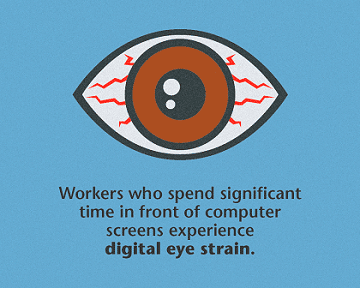Do you spend more than two hours a day looking at a digital screen? If the answer is “yes,” chances are you have experienced digital eye strain at some point. A recent study by The Vision Council found nine out of 10 people with digital eye strain use a device for two or more hours each day.
Symptoms of digital eye strain range from mild to debilitating and can include red, irritated or dry eyes, blurred vision, eye fatigue, back and neck pain and headaches. Most of these symptoms are temporary and generally disappear after a break from staring at a screen. However, some researchers are finding that consistent exposure to digital screens may be linked to long–term vision problems such as macular degeneration and cataracts. “Digital devices permeate our daily lives, and digital eye strain is the price we pay for using these technologies,” notes EMC Risk Improvement Consultant Laurie Hoskins.
Tips to Reduce Digital Eye Strain
While it’s unlikely workers will stop using digital devices any time soon, there are some things you can do to prevent eye strain while using a device.
- Take a 20/20/20 break. Every 20 minutes, take a 20–second break and look at something 20 feet away
- Visit an optometrist every year
- Blink more often to help keep eyes moist
- Dust and wipe digital screens to help reduce glare
- Increase text size to make it easier for you to read
- Lessen the amount of overhead and surrounding light that is competing with the device’s screen
- Adjust the brightness of the device
- Position your screen to a minimum of 24 inches from your eyes with the center of the screen being about 10 – 15 degrees below your eyes
- Use HEV–filtered glasses to help block out the high energy visible light that emits from your screen
Add Employee Education to the List
Hoskins has one more tip to add to The Vision Council’s list—education. “According to The Vision Council, one in three Americans do not take any action to reduce symptoms of digital eye strain,” notes Hoskins. “Therefore, it’s important to educate employees about the potential damage and how to alleviate the problem with some quick and easy adjustments.”
